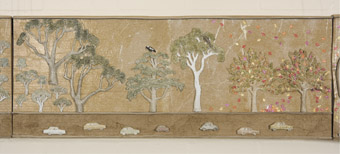 |
Elizabeth Paterson, Growing Home - the Street Trees of Canberra photo Stuart Hay |
So was born her project, Growing Home: the street trees of Canberra, a work which documents the development of Canberra’s green spaces from the plans of horticulturalist Thomas Weston through to the 1970s, a span of some 60 years.
Displayed at the National Botanical Gardens Visitors’ Centre, the work comprises a 12-metre scroll which wraps around three walls of the gallery. A papier mache bas relief, the work’s structure is based on the Bayeux tapestry, and like the Bayeux, it travels in time through a distinct narrative of events.
The piece is filled with recognisable historical detail, such as landforms of the area and different species of trees and birds. Paterson wrestled with her subject over the long making period: “Canberra is controlled, quiet, empty, slightly boring. Parts of me wanted to find something more exciting, but the content itself kept drawing me back.”
The artist finds she is “bemused, surprised, pleased” by the result. “It works in spite of me.” Whereas in other cities, architecture carries the Grand Human Narrative, Canberra’s story remains its struggle to overcome landscape. After the miracle of transforming vast limestone plains with gelignite, experimental plantings and an army of men planting rootstock, we are still left with a Great Emptiness characteristic of the Paddock. The city is laid out incorporating paddocks within it. The King of the Paddock, she says, is the Gum tree, and “gum trees want to push people out.”
While the earlier parts of the scroll are full of the activities of digging, planting, period tractors towing and lifting, visible human presence thins as our eyes traverse panels from the “building years” towards the 60s and 70s. In the earlier years, some scruffy dogs walk themselves amongst the men, plantings and earthworks; in later decades, a sole dog-walker heads off past parked cars.
Paterson began as a theatre maker, training in the late 1970s at the VCA. Her earliest independent works, such as The Old Woman at the Window [1980], show a tendency to present tableaux within a frame, hinting at stories formed outside of it. A later street theatre piece, The Odd Jalopy [1996-98], revealed its concerns with the kinds of rich, unspoken narratives that could be imagined from glimpsed arguments and exchanges, reveries and vignettes of immigrants, enacted by the two performers as they trundled the tin-pot vehicle along its journey through various venues and events.
Similarly, the panels of Growing Home capture a series of enactments within memory spaces. The scroll becomes a (partial) autobiography of the town. Its simple materials, quotidian action and play with space also link the work to the concerns of the legendary Polish theatre director Tadeusz Kantor, with whom Paterson studied in the 1980s and whom she credits as turning her from theatre towards visual arts.
One of the scroll’s chief characteristics is its restraint. No single tree—native or non-native—is too heroic (what can truly conquer that limestone soil?). No individual towers over the landscape. (Apparently, Weston and Walter Burley Griffin argued as Weston proved Griffin’s planting fantasies would fail.) In one panel, a tiny bust of Weston comes head-to-head with a rabbit.
The brown paper tone holds the piece, reminding us of the fundamental aridity of the region. It is also an historical touchstone, reminiscent of the brown paper packages of earlier times.
Technical challenges included finding a way to “flatten” the papier mache (“it doesn’t like it”) and discovering latex moulding as a way to achieve both repetition of the tiny features (the leaves of the trees) and detail (individual differences in cars, workmen, birds, rabbits).
“My next step”, says Paterson, “is to find the spontaneous—to move more away from historical narrative.” Yet these kinds of elements are already suggested, in the decorative “cornices” of the work, the rhythmic explorations of line and defining of space across the piece, and in the aforementioned vignette of man versus rabbit. “I’m in a state of looking for ‘what next’? A time of self-examination. What is exciting to me now?”
Elizabeth Paterson, Growing Home: the street trees of Canberra, National Botanic Gardens, Canberra, April 3-June 29
RealTime issue #85 June-July 2008 pg. 54
© Zsuzsanna Soboslay; for permission to reproduce apply to [email protected]








 back
back